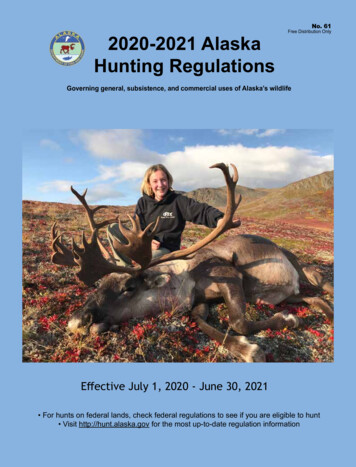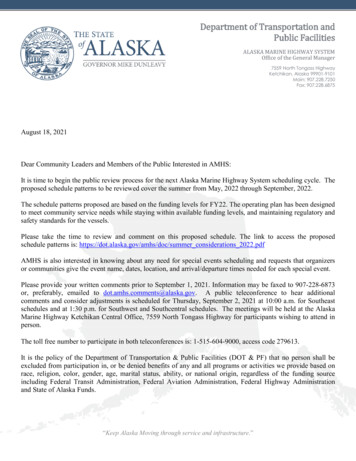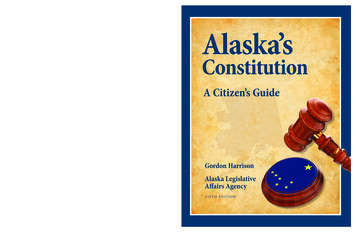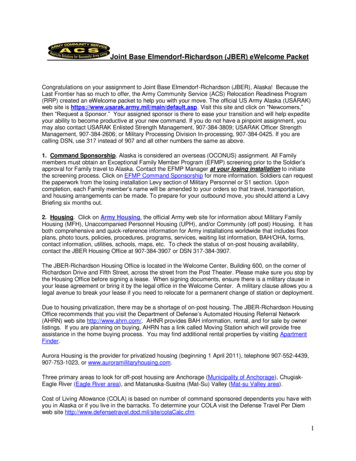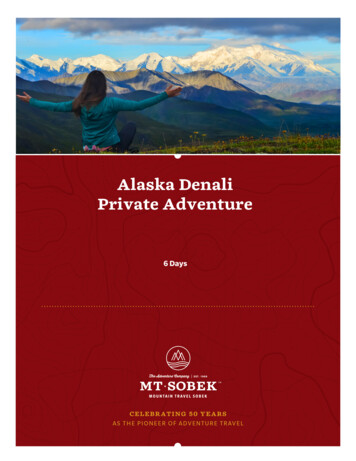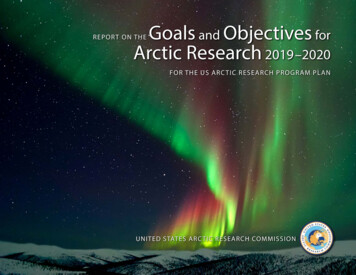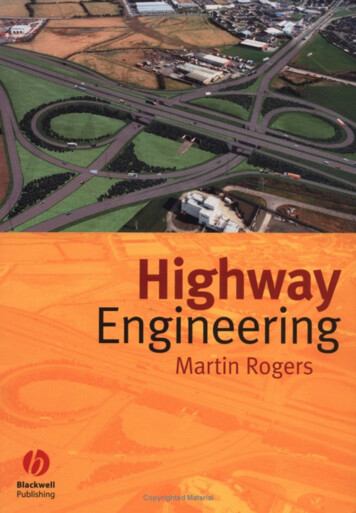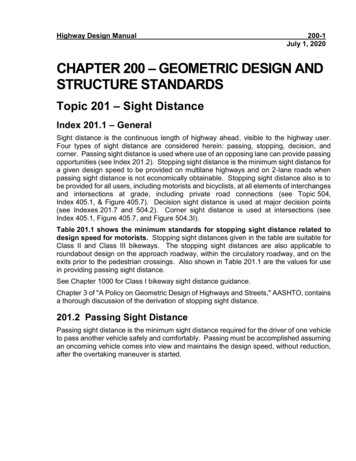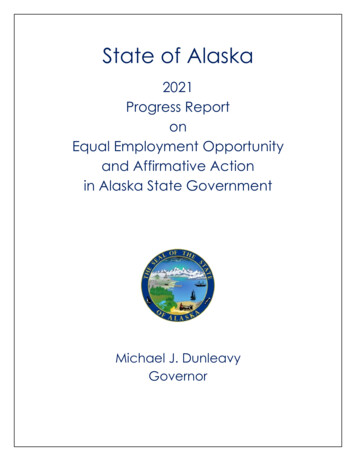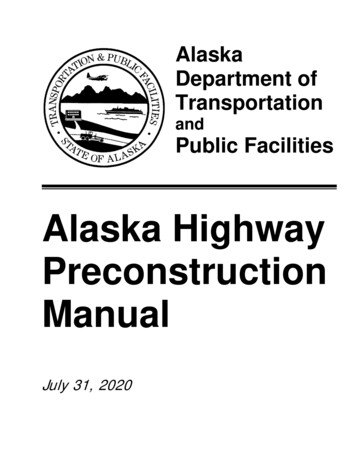
Transcription
AlaskaDepartment ofTransportationandPublic FacilitiesAlaska HighwayPreconstructionManualJuly 31, 2020
Alaska Highway Preconstruction Manual
Table of ContentsChapter 1.Abbreviations, Acronyms and Glossary . 1-1Chapter 2.Organization . 2-1Chapter 4.Project Development Process . 4-1Chapter 5.Public Involvement and Agency Coordination . 5-1Chapter 10. Highway Capacity . 10-1Chapter 11. Highway Design . 11-1Chapter 12. Non-Motorized Transportation . 12-1Chapter 14. Traffic Safety in Work Zones . 14-1Note: Each chapter begins with its own complete table of contents.Alaska Highway Preconstruction ManualITable of ContentsJuly 31, 2020
This page intentionally left blank.Table of ContentsJuly 31, 20202Alaska Highway Preconstruction Manual
1.Glossary100.Abbreviations, Acronyms, and Glossary . 100-1100.1. Abbreviations and Acronyms . 100-1100.2. Glossary . 100-3Alaska Highway Preconstruction Manual100-i1. GlossaryJune 15, 2018
This page intentionally left blank.1. GlossaryJune 15, 2018100-iiAlaska Highway Preconstruction Manual
100. Abbreviations, Acronyms, and Glossary100.1.100.2.Abbreviations and AcronymsGlossary100.1. Abbreviations and Acronyms3R:Resurfacing, Restoration, andRehabilitationCEA:Cost-Effective AnalysisCE:Categorical ExclusionCFR:Code of Federal RegulationsCGP:Construction General PermitCIP:Capital Improvement ProgramCL:CenterlineAAA:Authority to Appraise and AcquireCOA:Class of ActionAAC:Alaska Administrative CodeCR:Constructability ReviewAADT:Average Annual Daily TrafficCRO:Civil Rights OfficeCSS:Context Sensitive SolutionsCWA:Clean Water ActCZ:Clear ZoneDBE:Disadvantaged Business EnterpriseDD:Decisional DocumentDEC:Department of EnvironmentalConservationDEIS:Draft Environmental Impact StatementAASHTO: American Association of State Highwayand Transportation OfficialsABSM:Alaska Bridges and Structures ManualADA:Americans with Disabilities ActADF&G: Alaska Department of Fish and GameADT:Average Daily TrafficAHDM:Alaska Highway Drainage ManualAKFPDM: Alaska Flexible Pavement DesignManualDHV:Design Hourly VolumeALBDS:AASHTO LRFD Bridge DesignSpecificationsDNR:Department of Natural ResourcesAO:Administrative OrderDOL:Department of LaborAPDES:Alaska Pollution and DischargeElimination SystemDOT&PF: Alaska Department of Transportationand Public FacilitiesARRC:Alaska Railroad CorporationDPDR:Department Procedures and RegulationsAS:Alaska StatuteDPOL:Department PolicyATA:Authority to AdvertiseDSR:Design Study ReportATM:Alaska Traffic Manual (MUTCD withAlaska Supplement)EA:Environmental AssessmentEEO:Equal Employment OpportunityATP:Authority to ProceedEFH:Essential Fish HabitatB/C:Benefit/CostEIS:Environmental Impact StatementBMP:Best Management PracticesEO:Executive OrderCA:Certification AcceptanceEPA:Environmental Protection AgencyCCO:Chief Contracts OfficerAlaska Highway Preconstruction Manual100-1100. GlossaryJune 15, 2018
MASH:Manual for Assessing Safety HardwareMCL:Materials Certification ListMMCL:Master Materials Certification ListMMPA:Marine Mammal Protection ActMOA:Memorandum of AgreementMOU:Memorandum of Understandingmph:Miles Per HourFAST Act: Fixing America’s SurfaceTransportation ActMPO:Metropolitan Planning OrganizationFEIS:Final Environmental Impact StatementMRS:Management Reporting SystemFHPM:Federal Highway Program ManualMUTCD: Manual on Uniform Traffic ControlDevicesFHWA:Federal Highway AdministrationFONSI:Finding of No Significant ImpactFTA:Federal Transit AdministrationGB:Green Book. More specifically, theAASHTO A Policy on Geometric Designof Highways and StreetsEPM:NEPA Assignment ProgramEnvironmental Procedures ManualESA:Endangered Species ActESC:Erosion and Sediment ControlESCP:Erosion and Sediment Control PlanFAA:Federal Aviation AdministrationFAHP:Federal-Aid Highway ProgramGDVLVLR: Guidelines for Geometric Design ofVery Low-Volume Local Roads(AASHTO)GPS:Global Positioning SystemHCM:Highway Capacity ManualHEC-22:Urban Drainage Design Manual,Hydraulic Engineering Circular, No. 22MVM:Million Vehicle MilesNCHRP:National Cooperative HighwayResearch ProgramNEPA:National Environmental Policy ActNHS:National Highway SystemNMFS:National Marine Fisheries ServiceNOC:Notice of CancellationNOI:Notice of IntentNTP:Notice to ProceedP&P:Policy and ProcedurePDA:Project Development AuthorizationHOV:High Occupancy VehiclePE:Preliminary EngineeringHPCM:Alaska Highway PreconstructionManualPID:Project Information DocumentPIF:Public Interest FindingPIH:Plans in HandPIP:Public Involvement PlanPL:Public LawPM:Preventive MaintenancePMP:Project Management PlanPoDI:Projects of Division InterestPS&E:Plans, Specifications, and EstimatePSA:Professional Services AgreementHSIP:Highway Safety Improvement ProgramITE:Institute of Transportation EngineersITS:Intelligent Transportation SystemLA:Legislative AuthorityLON:Length of NeedLOS:Level of ServiceLPA:Local Public AgencystMAP-21: Moving Ahead for Progress in the 21Century Act100. GlossaryJune 15, 2018100-2Alaska Highway Preconstruction Manual
RDG:Roadside Design GuideT/W:Traveled WayREM:Regional Environmental ManagerUS:United StatesRIP:Roadway Information PortalUSACE:United States Army Corps of EngineersRLDG:Roadside Lighting Design GuideUSC:United States CodeROD:Record of DecisionUSCG:United States Coast GuardROW:Right-of-WayUSFWS:US Fish and Wildlife ServiceRPRL:Recommended Practice for RoadwayLighting (RP-8-14)V:Design Speed (expressed in miles perhour, unless otherwise noted)RSAP:Roadside Safety Analysis ProgramVE:Value EngineeringRTSE:Regional Traffic and Safety EngineerVLVLR:Very Low-Volume Local RoadR/W:Right-of-Wayvpd:Vehicles per DaySAFETEA-LU: Safe, Accountable, Flexible,Efficient Transportation Equality Act: ALegacy for UsersVSL:Value of Statistical LifeSD:Sight Distance100.2. GlossarySE:Systems EngineeringSEA:Systems Engineering AnalysisSEO:Statewide Environmental OfficeSHPO:Statewide Historic Preservation OfficeSNTB:Special Notice to Bidders6004: Section 6004(a) of SAFETEA-LU, whichallows DOT&PF to assume responsibility fordetermining whether certain designated activities areincluded within classes of action that arecategorically excluded from requirements forEnvironmental Assessments or EnvironmentalImpact Statements.SOA:Stewardship and Oversight AgreementSSD:Stopping Sight DistanceSSHC:Alaska Standard Specifications forHighway ConstructionAASHTO Bike Guide: The American Associationof State Highway and Transportation OfficialsGuide for the Development of Bicycle Facilities.STIP:Statewide Transportation ImprovementProgramAdjacent Path: A path alignment that closelyparallels the main roadway corridor.SWPPP:Storm Water Pollution Prevention PlanT&M:Time and MaterialsAdministrative Order (AO): An order issued byThe Governor to take certain corrective action, or torefrain from an activity. A list of AOs is found here:TAP:Transportation Alternatives ProgramTCP:Traffic Control PlanTL-3:Test Level 3TMDL:Total Maximum Daily LoadTOP:Traffic Operation PlanTRB:Transportation Research BoardAlaska Highway Preconstruction Manual85th Percentile Speed: The 85th percentile of thedistribution of observed hpAlaska Administrative Code (AAC): Theregulations implementing state law, referred to bytitle, chapter, and section e.g., 17 AAC laska Statutes (AS): Usually referred to by title,chapter, and section, e.g., AS 36.30.100.100-3100. GlossaryJune 15, 2018
vehicles traversing the segment, including allstopped delay Americans with Disabilities Act (ADA): Section504 of the Rehabilitation Act of 1973 (Public Law93-112, amended by PL 516 and PL95-602) requiresfederally funded facilities and programs to beaccessible to people with disabilities. A federal law(#103-366) enacted on July 26, 1990 that prohibitsdiscrimination against people with disabilitiesregarding access to programs, activities, or facilitiesprovided by state and local governments. Alsoincludes companion regulations in 28 CFR parts 35,36, 37, and 36 CFR part 1191.Backfill: Material used to replace or the act ofreplacing material removed during construction.Also may denote material placed or the act ofplacing material adjacent to structures.Bicycle Facility: A general term denotingimprovements and provisions to accommodate orencourage bicycling, including parking and storagefacilities, and shared roadways not specificallydefined for bicycle use.Bicycle Lane: A portion of roadway that has beendesignated for preferential or exclusive use bybicyclists by pavement markings and, if used, signs.It is intended for one-way travel, usually in the samedirection as the adjacent traffic lanes, unlessdesignated as a contra-flow lane.Annual Average Daily Traffic (AADT): The totalvolume of traffic passing a point or segment of ahighway facility in both directions for one yeardivided by the number of days in the year.Arterial Highway: That portion of the road systemwhich provides a high-volume, higher speednetwork for travel between major points in bothrural and urban areas.Borrow: An approved material required forembankments or for other portions of the work, andobtained from sources outside the right-of-waylimits for the project.At-grade Intersection: An intersection where allroadways join or cross at the same level.Bus: A self-propelled, rubber-tired road vehicledesigned to carry a substantial number of passengers(at least 16) and commonly operated on streets andhighways.Authority to Advertise (ATA): DOT&PF approvalto advertise a project for bids, requested in astandardized memo format. ATA is granted when allsignatures are obtained and any limiting conditionsor exceptions are satisfied.Capacity: The maximum sustainable hourly flowrate at which persons or vehicles reasonably can beexpected to traverse a point or a uniform segment ofa lane or roadway during a given time period underprevailing roadway, environmental, traffic, andcontrol conditions.Authority to Proceed (ATP): FHWA or DOT&PFapproval to proceed with the initial, or next stage ofproject development.Auxiliary Lane: The portion of the roadwayadjoining the through-traveled way for speedchange, turning, storage for turning, weaving, truckclimbing, or other purposes supplementary tothrough-traffic movement.Capital Improvement Plan (CIP): TheDepartment's plan for project activities spanning thenext six federal fiscal years.Categorical Exclusion (CE): A type ofenvironmental classification used on federal-aidhighway projects when there are no significantenvironmental impacts, as described in Section430.4.2.Average Daily Traffic (ADT): The total volumeduring a given time period (in whole days), greaterthan one day and less than one year, divided by thenumber of days in that time period.Certification Acceptance (CA): CertificationAcceptance. A program agreement with the FHWAcontained in the Stewardship and OversightAgreement (SOA) that grants the Departmentauthority to administer certain federally fundedroadway projects.Average Running Speed: The sum of the distancestraveled by vehicles on a highway section during aspecified time period divided by the sum of theirrunning times.Average Travel Speed: the length of the highwaysegment divided by the average travel time of all100. GlossaryJune 15, 2018100-4Alaska Highway Preconstruction Manual
Clear Runout Area: The additional clear zonespace that is needed because a portion of thesuggested clear zone falls on a non-recoverableslope. The width of the clear runout area is equal toportion of the clear zone distance that is located onthe non-recoverable xt Sensitive Solutions (CSS): Acollaborative interdisciplinary approach thatinvolves interested stakeholders in developing atransportation facility that, to the extent practical,maintains or enhances mobility, provides a highlevel of safety, fits its physical setting and preservesscenic, aesthetic, historic, cultural andenvironmental values and resources. CSS is anapproach that considers the total context withinwhich a transportation improvement project exists.Clear Zone (CZ): The unobstructed, traversablearea provided beyond the edge of the throughtraveled way for the recovery of errant vehicles. Theclear zone includes shoulders, bike lanes, andauxiliary lanes, except those auxiliary lanes thatfunction like through lanes.Code of Federal Regulations (CFR): Regulationsthat implement federal law, referred to by title, part,and section, e.g., 23 CFR 630.114. Title 23 coversHighways.Controlling Design Criteria: Design criteriaidentified by FHWA as having substantialimportance to the operational and safetyperformance of any highway such that specialattention should be paid to them in design decisions.See Section 1100.3.2. for a listing.https://www.ecfr.gov/cgi-bin/textidx?tpl %2Findex.tplCross-slope: The slope across the traveled way,auxiliary lane, or shoulder of a roadway. Usuallyexpressed in percentage of fall in feet of the roadwayper foot of width.Collector Road: A road collecting traffic fromlocal roads and channeling it to the arterial system.Collector-Distributor Road: A continuousroadway without local access provided parallel to afreeway mainline through one or more interchangesfor the purpose of removing weaving movements orclosely spaced merges and diverges from themainline.Cul-de-sac Street: A local street open at one endonly. A cul-de-sac should have a special turningarea at the closed end.Department: The Alaska Department ofTransportation and Public Facilities (DOT&PF).Collector Street: A public highway, usuallyserving moderate traffic volumes. Collector streetsserve a dual function: collecting traffic formovement between arterial streets and local roads,and providing access to abutting properties.Collector streets link neighborhoods or areas ofhomogenous land use with the arterial streetsystems. These streets not only serve trafficmovements between arterials and local streets, butalso serve through traffic within local areas.Design Criteria: Minimum dimensional values orranges of values for various elements of the threedimensional design features of a highway.Design Exception: A documented approval todesign a highway element or segment(s) of ahighway project using a criterion that does not meetstandards when that criterion is one of thecontrolling criteria adopted by FHWA. See Section1100.3.2.Commissioner: The Commissioner of the AlaskaDepartment of Transportation and Public Facilities.Design Hourly Volume (DHV): The DHV used indesign is generally the 30th highest hourly volume ofthe year, abbreviated as 30 HV, which is typicallyabout 15 percent of the ADT on rural roads.Construction: Defined in AS 19.59.001(2) asconstruction, reconstruction, alteration,improvement, or major repair.Design Speed (V): A selected speed used todetermine the various geometric design features ofthe roadway. The assumed design speed should be alogical one with respect to the topography,anticipated operating speed, the adjacent land use,and the functional classification of highway.Construction is also defined in 23 USC 101(a)(4) asit applies to most FHWA funded projects. Thisdefinition is particularly important in the context ofa project’s eligibility for FHWA funding.Alaska Highway Preconstruction Manual100-5100. GlossaryJune 15, 2018
evaluates their potential environmental effects,commits to measures necessary to mitigate adverseimpacts, and includes agency coordination andpublic involvement. The type of document(classification), as defined in 23 CFR 771.115,depends on the project's environmental impact. Itmay be an EIS, CE, or EA, as described in Section430.4.2. An environmental document may also benecessary on a state-funded project that requiresaction by a federal agency, such as federal permits orclearances.Design Standards: Design criteria, typically frompublished policies or guidelines, that are adopted byregulation or included in Table 1100-1. Designstandards establish a uniform set of values to use asthe basis for project design.Design Study Report (DSR): A formal report thatdocuments the preferred design solution. Approvalof the DSR constitutes Design Approval. SeeSection 450.5.1.Design Vehicle: A selected motor vehicle, theweight, dimensions, and operating characteristics ofwhich are used in highway design.Environmental Assessment (EA): A type ofenvironmental classification used on federal-aidhighway projects when the extent of environmentalimpacts is uncertain. The EA results in either aFinding of No Significant Impact (FONSI) or adecision to develop an Environmental ImpactStatement (EIS), as described in Section 430.4.2.Design Waiver: A documented approval to designa highway element or a segment(s) of a highwayproject using a design criterion that does not meetstandards, when that criterion is not one of theFHWA controlling criteria. See Section 1100.3.2.Disadvantaged Business Enterprise (DBE): Afor-profit business concern that: (1) is at least 51percent owned by one or more individuals who areboth socially and economically disadvantaged or, inthe case of a corporation, in which 51 percent of thestock is owned by one or more such individuals; and(2) Whose management and daily businessoperations are controlled by one or more of thesocially and economically disadvantaged individualswho own it.Environmental Impact Statement (EIS): A typeof environmental classification used on highwayprojects when a significant environmental impact isanticipated, as described in Section 430.4.2. Theconcluding action on an EIS results in a Record ofDecision (ROD) through the federal agency withjurisdiction.Ditch: A channel cut in the surface of the ground fordrainage purposes. Usually parallel and adjacent tothe roadway.Expressway: A high-speed divided arterialhighway for through traffic with access partially orfully controlled and grade-separations at majorintersectionsExecutive Order (EO): Legally binding ordersgiven by the President of the United States to federalagencies.Divided Highway: A highway with separatedroadways for traffic in opposite directions.FAST Act: Fixing America’s SurfaceTransportation Act of Dec. 4, 2015.DOT&PF: The Alaska Department ofTransportation and Public Facilities. Also referredto in this manual as the Department.Federal-Aid Highway Program Policy andGuidance Center (PGC): A web-based searchablesource of official FAHP policy and guidancedocuments.DPDR: Department Procedures and Regulations.See also P&P.https://www.fhwa.dot.gov/pgc/DPOL: Department Policy. See also P&P.Federal-Aid Policy Guide (FAPG): The collectionof policies, procedures, and directives from theFHWA for administering the federal-aid program.The FAPG has been terminated and guidance is nowfound at the Federal-Aid Highway and ProgramPolicy and Guidance Center.Embankment: A structure of soil, soil-aggregate, orbroken rock between the embankment foundationand the subgrade.Environmental Document: A report required onall federal-aid capital projects because of theNational Environmental Policy Act (NEPA). Itsummarizes the alternative courses of action,100. GlossaryJune 15, 2018100-6Alaska Highway Preconstruction Manual
Federal Aviation Administration (FAA): Usuallyrefers to the Alaska Region offices in Anchorage.Canadian highway, and any such related facility.Defined in AS 19.59.001(8).Federal Highway Administration (FHWA):Usually refers to the Alaska Division offices inJuneau.Highway Safety Improvement Program (HSIP):A federally-mandated program to identify, evaluate,prioritize, and fund highway safety improvements.The HSIP focuses on reducing or eliminating fataland serious injury crashes on all public roads.Federal Transit Administration (FTA): Sisteragency to the FHWA and FAA, administrating thefederal transit program. The regional office islocated in Seattle, Washington.Highway, Street, or Road: Recommended usage:In urban areas – highway or street. In rural areas –highway or road.Final Plans, Specifications, and Estimate (PS&E):The final PS&E assembly, with corrections madefrom the PS&E review, ready for advertisement.Finding of no Significant Impact (FONSI): Anenvironmental assessment conclusion, as describedin Section 430.4.2, signed by the federal agency withjurisdiction.Freeway: An expressway with fully controlledaccess.Frontage Road: A local road auxiliary to andlocated adjacent to the side of an arterial highwayfor service to abutting property and adjacent areasand for control of access. Highway: A general term denoting a publicway for vehicular travel, including the entirearea within the right-of-way. Road: A general term usually denoting arural public way for vehicular travel,including the entire area within the right-ofway. Street: A general term for an urban orsuburban public way for vehicles, includingthe entire area within the right-of-way.See Section 1.3 of the Green Book for definitions ofurban and rural areas.Functional Group: Same as Support Group.Horizontal Clearance: The horizontal distancefrom the edge of traveled way to a roadside object orfeature.Gore: The area immediately beyond the divergenceof two roadways bounded by the edges of thoseroadways.Interchange: A system of interconnecting roadwaysin conjunction with one or more grade-separations,providing for the movement of traffic between twoor more roadways on different levels.Grade: The level or elevation of something, or thelongitudinal slope of an alignment.Grade-Separation: A crossing of two highways, ora highway and a railroad, at different levels.Intersection: The general area where two or morehighways join or cross, which includes the roadwayand roadside facilities for traffic in that area. Whereseparate right-turn roadways are provided throughuse of curbed or unpaved islands, the intersections ofthe turning roadway with the other highways areconsidered separate intersections.Gravel to Pavement Project: A road constructionproject with the primary purpose of reducingmaintenance costs and improving roadway drivingcharacteristics by hard surfacing gravel roads inaccordance with the guidance provided in Section1160.4 of this manual.Green Book (GB): AASHTO A Policy onGeometric Design of Highways and Streets.Interstate: Interstate is the highest level of principalarterial, primarily rural. Interstates connect largepopulation centers.Highway: A highway (whether included in primaryor secondary systems), road, street, trail, walk,bridge, tunnel, drainage structure and other similaror related structure or facility, and right-of-waythereof, and further includes a ferry system, whetheroperated solely inside the state or to connect with aIsland: A defined area between traffic lanes forcontrol of vehicle movements or for pedestrianrefuge. Within an intersection, a median or an outerseparation is considered an island. A right-turn lanecreated with a painted island is not considered aseparate turning roadway.Alaska Highway Preconstruction Manual100-7100. GlossaryJune 15, 2018
MAP-21: The Moving Ahead for Progress in the21st Century Act (P.L. 112-141) enacted on July 6,2012 that funds surface transportation programs.Intelligent Transportation System (ITS):Electronics, communications, or informationprocessing used to improve the efficiency or safetyof a surface transportation system.Markings: All lines, patterns, words, colors, orother devices, except signs, set into the surface of,applied on, or attached to the pavement or curbing orto objects within or adjacent to the roadway,officially placed for regulating, warning, or guidingtraffic.Intelligent Transportation System (ITS) Project:Any project that in whole or in part funds theacquisition of technologies that provide orsignificantly contribute to the provision of one ormore ITS user services as defined in the NationalITS Architecture.Median: The portion of a divided highwayseparating the traveled ways of opposing traffic.Legislative Authority (LA): Approval given by theAlaska Legislature to the Executive Branch to spendstate or federal funds towards a specific project. Alegislative authority citation is given asww.xx.yy.zz, where ww is the chapter, xx is theyear, yy is the page, and zz is the line.Median Opening: A gap in a median provided forcrossing and/or turning trafficMetropolitan Planning Organization (MPO): AnMPO carries out transportation planning for urbanareas with a population greater than 50,000 people.Defined in Federal Regulation 23 USC Sec. 134 (b)through (d). This includes Anchorage andFairbanks.Length of Need (LON): Total length of alongitudinal barrier needed to shield an area ofconcern. The length of need point for a givensystem is usually confirmed by successfully passinga redirection crash test with impact at the length ofneed point.Mid-block Crossing: Intersections formed whenpaths or sidewalks cross other transportationfacilities at locations other than roadway-to-roadwayintersections.Level of Service (LOS): A quantitativestratification of a performance measure or measuresthat represent a quality of service, measured onan A - F scale, with LOS A representing the bestoperating conditions from the traveler’s perspectiveand LOS F the worst.Mid-Design Period ADT: The projected ADT thatoccurs at a point in time equal to one-half the projectdesign life.National Highway System (NHS): The NHSincludes the Interstate System; Congressional HighPriority Routes; National Defense Roads (i.e. theStrategic Highway Network); and principal arterialroutes or other routes that connect intermodalfacilities.Local Road: A road primarily for access to homes,businesses, or other abutting property.Local Street: A street primarily for access tohomes, businesses, or other abutting property.Maintenance: The preservation of each type ofhighway, roadside structure, and facility as nearly aspossible to its original condition as constructed, or assubsequently improved, and the operation ofhighway facilities and services to providesatisfactory and safe highways. Defined in AS19.59.001(9). See also Preventive Maintenance andRoutine Maintenance.National Environmental Policy Act (NEPA)Assignment Program: The surface transportationproject delivery program established in 23 U.S.C.327 allows DOT&PF to assume FHWA’sresponsibilities under NEPA.New Construction: A major highway improvementthat constructs a roadway, on new alignment, to thedesign requirements of the Green Book, and theAlaska Highway Preconstruction Manual.Major Highway: An arterial highway, withintersections at-grade and direct access to abuttingproperty, on which geometric design and trafficcontrol measures are used to improve the safety ofthe movement of through traffic.100. GlossaryJune 15, 2018New Construction - Reconstruction: A majorhighway improvement that completely rebuilds anexisting roadway or constructs a roadway on newalignment, to the contemporary design requirements100-8Alaska Highway Preconstruction Manual
of the Green Book, and the Alaska HighwayPreconstruction Manual.users, joggers, skiers, and other non-motorized usersmay use paths.Non-Motorized Transportation: Transportation byhuman power, including bicycling, walking, in-lineskating, skiing, and other methods.Pavement Replacement: The replacement of theentire existing pavement structure by the placementof new pavement structure.Non-NHS: A term used to designate roads otherthan those on the NHS. Non-NHS roads are to bedesigned, constructed, operated, and maintained inaccordance with state laws, regulations, directives,safety standards, design standards, and constructionstandards.Pavement replacement may utilize either new orrecycled materials incorporated into the materialsused for the replacement of the existing pavementsection. Pavement replacement is required when apavement has either failed or has becomefunctionally obsolete.Non-recoverable Slope: A slope that is consideredtraversable but on which the errant vehicle willcontinue on to the bottom. Embankment slopesbetween 3:1 and 4:1 may be considered traversablebut non-recoverable if they are smooth and free offixed objects.Pavement Rehabilitation: Structuralenhancements that extend the service life of anexisting pavement and/or improve its load carryingcapacity. Rehabilitation techniques includerestoration treatments and structural overlays.Pavement Structure: The combination of selectmaterial, subbase, base, and surface course placed ona subgrade to support the traffic load and distribute itto the roadbed (42 inches below the asphalt concretelayer).Notice of Intent (NOI): The official notificationthat a federal agency is beginning the process toprepare an Environmental Impact Statement (EIS).Operating Speed: The speed at which drivers areobserved operating their vehicles during free-flowconditions. The 85th percentile of the distribution ofobserved speeds is the most frequently used measureof the operating speed associated with a particularlocation or geometric feature. This speed may behigher or lower than posted or legislated speed limitsor nominal design speeds where alignment, surface,roadside development, or other features affectvehi
AASHTO Bike Guide: The American Association of State Highway and Transportation Officials Guide for the Development of Bicycle Facilities. Adjacent Path: A path alignment that closely parallels the main roadway corridor. Administrative Order (AO): An order issued by The Governor to take c
